Choosing Footwear That Prevents Blisters Effectively
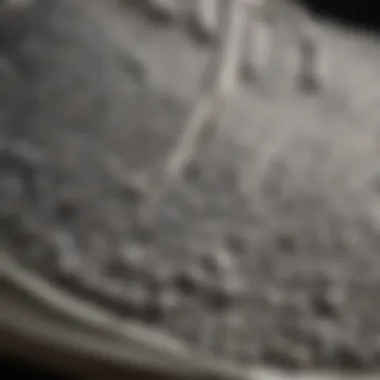
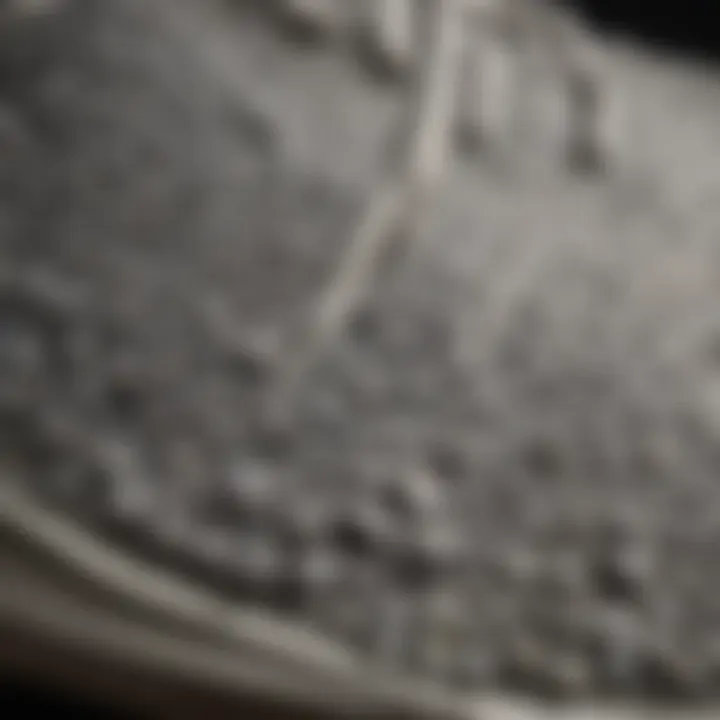
Intro
When it comes to maintaining our physical health, a peculiar yet significant aspect often flies under the radar: footwear. Shoes may seem like a minor detail in our daily lives, yet they play a pivotal role in how we feel, particularly during extended periods of walking or standing. One common ailment that many people encounter is blisters, which can be not only painful but also a hindrance to our mobility and overall enjoyment of activities.
Understanding the anatomy of blisters is crucial. These pesky fluid-filled bubbles form as a protective response to friction, often exacerbated by poorly fitting or inappropriate shoes. Thus, the selection of suitable footwear becomes paramount.
This article aims to dissect effective strategies for picking shoes that minimize blister risks, shedding light on material choices, design attributes, and fitting strategies. With expert insights, we will navigate the labyrinth of options available today, empowering readers to make informed decisions designed not just for comfort but also for durability. Plus, there will be practical tidbits on shoe maintenance and alternatives when your ideal shoe is out of reach.
So, whether you are gearing up for a long hike, a day at the office that keeps you on your feet, or a leisurely stroll around the park, choosing the right footwear can be the difference between thriving or barely surviving.
Wellness
Physical Health
Our feet are the unsung heroes of our bodies. They bear our weight and endure pressure, often without complaint. But if the wrong footwear is chosen, this could lead to various issues, including blisters, corns, and even long-term damage to the foot. Proper shoes should distribute weight evenly, reduce friction, and provide support where it’s needed the most.
Choosing shoes made from breathable materials like mesh or soft leather can make all the difference. This promotes air circulation, which helps in wicking away moisture. Moisture mixed with friction is a recipe for disaster when your goal is to prevent blisters.
Mental Health
Let’s take a step beyond the physical. Did you know that the right footwear can also impact your mental state? Whether you're walking into a meeting or simply going about your day, comfortable shoes can boost your confidence. No one enjoys the distraction of sore feet. When you know you're well-equipped, every step feels lighter, in both body and mind.
Nutrition and Diet
While it may seem kilometers away from foot health, nutrition plays its part too. Proper hydration helps maintain skin elasticity, reducing the risk of blisters. Additionally, a balanced diet rich in vitamins can support skin health, ensuring that your skin remains resilient against tears and friction.
Fitness and Exercise
For fitness enthusiasts, the right footwear is non-negotiable. Whether you’re hitting the pavement for a run or engaging in high-intensity workouts, your shoes need to align with the specific needs of your activity. Specialized running shoes, cross-trainers, and even hiking boots are designed with particular features to provide the necessary support and comfort required for various forms of exercise.
"Investing time in understanding what your feet need can spare you from a world of hurt later on."
Next, we will explore the finer details regarding the fitting of shoes and what characteristics to look for, ensuring a seamless transition into comfort and health for your feet.
Understanding Blisters and Their Causes
Choosing the right footwear begins with understanding the underlying issues that contribute to blisters. Blisters can be quite the irritation; they serve as a painful reminder that our feet deserve more attention. Recognizing the biology of blisters and knowing their common triggers can be a game changer when selecting shoes. This understanding not only allows individuals to make informed decisions on footwear but also enhances overall foot health. Knowing what causes blisters is half the battle won, enabling you to dodge those pesky nuisances.
Biology of Blisters
Blisters form when the layers of skin are subjected to repeated friction or pressure. This can be a result of ill-fitting shoes or the wrong type of sock material. When friction occurs, the skin can separate, leading to an accumulation of fluid beneath the outer layer. Essentially, the body is trying to protect itself. Think of it as your feet building a cushion, albeit a very uncomfortable one. The inner layers of skin produce fluid to provide a barrier against the outer stressors.
Typically, blisters can manifest on any part of the foot, but certain areas like the heel or the sides of the toes are often more vulnerable. Most people might casually dismiss the pain until it becomes unbearable, at which point it's hard to ignore. A thorough understanding of this biological response can help in taking the right steps toward prevention.
Common Triggers
There are several factors that can lead to the unwanted occurrence of blisters. Among those are:
- Friction: This is perhaps the most prevalent cause. Whether you're hiking a trail or jogging down the street, the constant rubbing of your skin against the shoe material can result in blisters.
- Moisture: Wet feet are grief-stricken feet. When skin is damp, it becomes more susceptible to damage. This is why sweaty feet or wet conditions can be a setup for blisters.
- Wrong Size Shoes: Wearing shoes that either pinch your feet or are too loose can also exacerbate friction. A shoe that doesn't fit well can cause all sorts of issues that lead to blisters—not to mention discomfort.
- Activity Level: The more you're on your feet, whether running errands or engaging in sports, the higher the chance you’ll rub against your shoes.
"Understanding these triggers can empower you to make better choices, ultimately keeping your feet blister-free and comfortable."
Awareness of these causes and triggers is crucial for anyone looking to keep their feet in prime condition. It’s not just about aesthetics; it’s about creating an environment that promotes foot health, especially during activities that demand a lot from your footwear. By owning the knowledge of how blisters arise, you can effectively choose the right shoes designed to tackle these challenges head-on.
Footwear Design Principles
When it comes to preventing blisters, understanding the principles of footwear design is essential. The way a shoe is crafted can make all the difference in the comfort level during various activities. Good design principles consider factors such as materials, construction methods, and the wearer's needs. Choosing shoes that adhere to these principles can significantly improve overall foot health.
Material Selection
Breathability
Breathability in footwear is all about how well the shoe allows air circulation. This characteristic is crucial in minimizing moisture buildup within the shoes, which is a leading cause of blisters. Breathable materials, often found in running shoes and hiking boots, facilitate a cooling effect, helping to keep your feet dry. One key feature of breathable shoes is their use of mesh panels or specially designed fabrics that allow heat and moisture to escape. While breathable shoes enhance comfort, they can sometimes offer less insulation in colder temperatures. This trade-off is worth considering if you're in areas where temperature variability is a factor.
Moisture-Wicking Properties
Moisture-wicking properties refer to the shoe's ability to draw moisture away from the skin. Materials with moisture-wicking capabilities actively pull sweat away from your feet, keeping them dry and reducing friction that leads to blisters. A notable aspect of moisture-wicking is how it interacts with different climates; in humid conditions, these materials remain vital to maintain comfort. However, it’s important to look for shoes that also have a durable outer layer, as some moisture-wicking material might not be very robust against rough terrains.
Softness and Flexibility
Softness and flexibility in shoe design directly affect how well a shoe can conform to your foot's shape. A soft upper material can provide a snug yet gentle fit that minimizes pressure points where blisters often form. Flexible shoes allow for a natural foot movement, enabling your foot to expand comfortably with each step. However, be cautious about opting for overly soft shoes, which might lack support and lead to instability, especially on uneven surfaces.
Shoe Construction
Cushioning
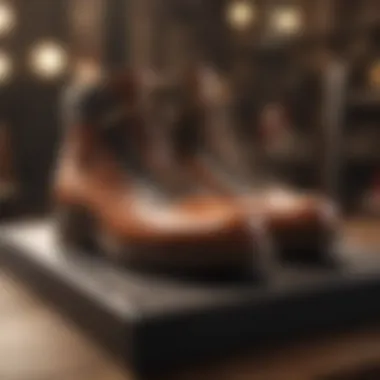

Cushioning is a critical element when it comes to reducing impact and enhancing comfort during movement. Shoes with good cushioning can absorb shock, lessening the stress on your feet, knees, and back. A key feature of cushioning is the use of advanced foam materials that provide significant comfort without being overly bulky. Adequate cushioning can prevent blistering by reducing the intensity of rubbing against your foot. However, too much cushioning can compromise stability, which is vital for activities that involve rapid movements.
Arch Support
Arch support is vital for promoting proper foot alignment. It helps distribute weight evenly across your feet and reduces the risk of developing blisters from uneven pressure. Well-designed arch supports can also alleviate fatigue during long periods of standing or walking. It's essential to note that not all feet are created equal; so individualized arch support can greatly enhance comfort and performance. Some shoes even offer customizable insoles to cater to varying arch types, which can be hugely beneficial.
Heel Design
Heel design significantly influences how a shoe fits and performs. A well-structured heel can provide stability and prevent excessive movement that can lead to blisters. Many shoes have features like heel counters, which lock the heel in place, ensuring it doesn��’t slide. The dropout angle of the heel, whether it be flat or elevated, also affects the comfort and motion dynamics. A drawback to consider is that overly rigid heel designs can sometimes lead to discomfort and contribute to blister formation in sensitive feet.
Proper footwear design principles are the armor against painful blisters, enabling a more enjoyable experience during sports and daily activities.
In summary, understanding the intricacies of footwear design principles is not just about fashion or style; it’s about ensuring utmost comfort and reducing the risk of blisters. By selecting shoes with careful consideration of materials and construction, wearers can maintain foot health while engaging in their favorite activities.
Key Features to Look for in Shoes
When it comes to keeping those pesky blisters at bay, the features of your footwear cannot be overlooked. Proper shoes are not just a matter of style; they can genuinely take a toll on your comfort and health. The goal here is to ensure that each time you slip on a pair, you're not just checking off a box but actively preventing blisters.
Size and Fit Analysis
Measuring Your Feet
Diving into the specifics, measuring your feet is a crucial first step for a good fit. You might think it’s something that’s only needed for kids, but adults often forget that feet can change over time. Measurement should be done while standing up, because this ensures the arch of your foot is in its true position. Using a Brannock device or even a tape measure can help you get accurate dimensions.
One key characteristic is that your feet should be measured in the afternoon when they’re slightly swollen. This is a common state for feet during daily activities, so it makes sense to account for that. An ill-fitted shoe can lead to a lot of discomfort, and sometimes, even blisters.
Thus, every little millimeter matters when it comes to size. A shoe that’s too small may rub against your toes, while one that’s too big could cause excess movement within the shoe, leading to friction. It’s smart to check both length and width for the best overall fit.
Allowing for Toe Space
Another facet to consider is allowing enough space for your toes. A good rule of thumb is that there should be about a thumb's width of room between your longest toe and the end of the shoe. This extra space is essential for preventing your toes from squeezing tightly together, which can lead to discomfort and, ultimately, blister formation.
Toe space enhances overall comfort and functionality; it gives your feet room to expand naturally during activities. If your shoes fit like gloves with no extra space, think twice! Not only can it lead to blisters, but it can also cause long-term issues like hammer toes or bunions. Remember, your feet aren’t just there for show; they’re working hard to keep you moving!
Considering Sock Thickness
The thickness of your socks plays a surprisingly important role in blister prevention. If you usually go for thicker socks, wearing them with thin shoes might cause friction, leading to blisters. Conversely, if you have high-performance shoes designed for thin socks, you’ll need to stick to that trend.
In choosing socks, look for moisture-wicking materials, which help keep feet dry and comfortable. Having the right amount of cushioning is also significant as too much can make a shoe feel tight. Think of socks as an integral part of your fit. They should complement the shoe rather than complicating the fit.
Support and Stability Considerations
Importance of Ankle Support
Don’t underestimate the power of ankle support in your footwear. Whether you're walking down the street or tackling rough terrain, a solid ankle support can make world of difference. A shoe without this could allow for excessive motion of the ankle, which can lead to friction on the foot itself.
The right level of support helps maintain proper alignment and function, reducing the risk of blisters formed through repeated motion. Shoes that cradle the ankle promote stability, which can lead to longer, pain-free periods of wear. Consider styles with padded collars which give that little extra support needed for longer wear.
Midsole Technology
Midsoles are another often overlooked feature. They serve as the cushioning layer and significantly affect shock absorption, directly relating to foot fatigue and comfort. Midsoles that are too firm might not provide enough comfort for prolonged activities, while those that are overly soft can lead to instability.
Research indicates that properly engineered midsole technology can greatly reduce the impact on your joints, preventing not only blisters but overall wear and tear. There’s a range of materials available from EVA to polyurethane; understanding their properties can help in making a suitable choice.
Footbed Customization
Finally, let’s talk about footbed customization! Not everyone’s feet are the same, of course, so using prefabricated insoles might not always cut it. Orthotic solutions or personalized footbeds can drastically improve the fit and comfort of shoes, especially if you have specific foot issues.
A customized footbed can redistribute pressure from high-traffic areas of the foot and can also offer better arch support. The unique feature of footbed customization is its ability to cater to the specific contours of your foot, leading to a marked reduction in friction and risk of blister formation.
"Choosing shoes that support and stabilize is paramount in keeping blisters at bay and ensuring comfort during activities."
Take the time to assess these various key features when selecting your footwear. With the right size, sufficient toe space, suitable sock thickness, effective ankle support, responsive midsole technology, and thoughtful footbed customization, you take a significant step towards blister-free days.
Types of Footwear Based on Activities
Choosing the right footwear tailored to specific activities is crucial in preventing blisters and ensuring overall foot comfort. Different activities demand different shoe designs, materials, and constructions. Not all shoes are created equal; some are specifically engineered for particular endeavors. For instance, running shoes prioritize cushion and support for forward motion, while hiking boots are crafted to withstand rugged terrain and provide ankle support. Casual footwear may focus more on aesthetic appeal, yet it must also offer comfort during extended wear. Each footwear type comes with its set of features that can make a significant difference in both performance and the risk of developing blisters.
Running Shoes
Performance Considerations
When it comes to performance considerations, running shoes are designed with features that cater specifically to the needs of runners. Key traits include lightweight materials, shock absorption, and breathability. These elements contribute greatly to minimizing the strain on feet during runs. A lightweight running shoe allows runners to maintain speed without excessive fatigue, while shock absorption helps to mitigate impact, which is critical to reducing the likelihood of developing blisters. However, the effectiveness of this design lies in how well it aligns with individual running patterns. If they don't match a runner's gait, even the best performing shoe can end up feeling like a lead weight.
Recommended Brands
There’s a plethora of brands that excel in producing high-quality running shoes. Notable names include Asics, Brookes, and New Balance, each known for their commitment to comfort and performance. These brands often incorporate unique features such as custom-fit technology or adaptive cushioning, making them stand out in a crowded market. However, it is essential to understand that while these brands are generally reputable, personal preference plays a significant role. What works wonderfully for one runner may cause discomfort for another.
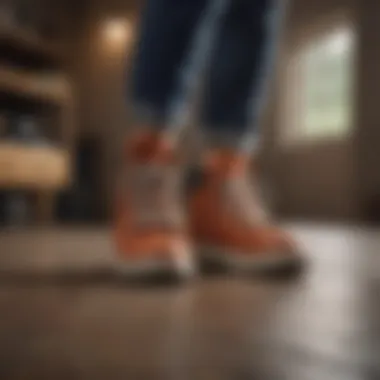
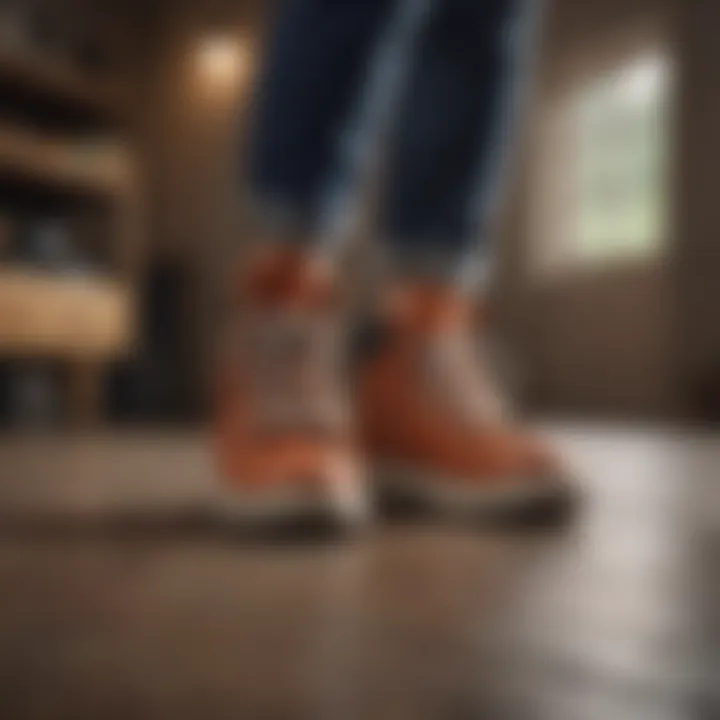
Hiking Boots
Soil and Terrain Adaptations
Soil and terrain adaptation features are critical when selecting hiking boots as they dictate how well a boot can perform across various landscapes. Hiking boots with robust lugs provide traction to grip uneven surfaces - vital for tackling rocky paths or muddy trails. A boot that adapts well to different terrains allows hikers to navigate confidently without fearing slips or falls. Also, waterproofing features can be a game changer in wet conditions, although they may add extra weight.
Features for Comfort
Features that enhance comfort in hiking boots can make or break an enjoyable trek. This includes padded collars for ankle support, cushioned footbeds, and moisture-wicking linings. Comfort-focused designs help reduce friction that can lead to blisters, especially on long hikes. It’s worth noting, though, that excessively cushy boots may risk losing stability, which is paramount on more challenging hikes. Striking a balance between comfort and support is key.
Casual Footwear
Everyday Comfort
Looking at casual footwear, everyday comfort is paramount as these shoes are often worn for extended periods. Features like cushioned soles and soft, breathable materials contribute to creating a comfortable experience. For example, sneakers made with fabric that allows airflow can greatly reduce the sweat, which is a critical factor in blister formation. However, one should also take into account the arch support and overall fit, as poorly fitting casual shoes can lead to discomfort just like hiking or running shoes.
Style vs Comfort
The debate between style and comfort often surfaces when selecting casual footwear. While many styles focus on the latest trends, this can sometimes come at the cost of comfort. Shoes that look great but lack adequate support can lead to foot fatigue and blisters over time. Ideally, one would find footwear that marries both attributes, although it frequently requires patience and diligence to search through various options. A stylish shoe that sacrifices support isn’t worth the pain down the line.
Choosing footwear based on specific activities can prevent blisters and enhance foot comfort, which is crucial for maintaining foot health.
In summary, when trying to choose the right footwear, understanding the demands of your activity can inform your choices. Whether it’s for running, hiking, or casual wear, each type of footwear has its unique characteristics that can aid in comfort and prevent those pesky blisters.
Adapting Shoes to Your Feet
Finding the right shoes is not just about picking the latest trendy pair off the shelf; it's about making them work for you. Adapting shoes to your feet is a crucial step in preventing blisters. When shoes don’t fit snugly or lack compatibility with your foot shape, friction can lead to painful blisters. Matching the shoe’s characteristics to your unique foot structure means paying attention to how they load your foot and how they move with you. A proper fit increases comfort and enables better overall performance, whether you’re doing casual walks or engaging in rigorous activities.
Break-In Period
Gradual Usage
Gradual usage essentially means introducing your new shoes to the world—slowly. This method allows your feet to become accustomed to the new fit and feel, reducing any potential woes during that initial period. By easing into it, you give your feet the opportunity to adjust without being overwhelmed. A key characteristic of gradual usage is to wear the shoes for short spells—such as a quick jaunt to the store—before committing to longer outings. This approach is viewed as beneficial, especially for individuals with sensitive skin or pre-existing foot issues. Unlike the quick-start method, where one might don the shoes for an entire day and suffer later, gradual usage lets your feet dictate how much they can take. A downside could be the lingering new-shoe scent, but that's a small price to pay for happy feet.
Signs of Comfort
Recognizing signs of comfort as you break in new shoes is pivotal. Comfortable shoes should not pinch or rub; they should feel snug but never suffocating. You’ll often notice signs of comfort like minimal pressure in key areas, a lack of redness or soreness, and the ability to move your toes. This aspect contributes significantly to the overarching goal of avoiding blisters. If you notice that your heel slips or your toes feel cramped, these are red flags signaling ill fitting that could lead to issues later. Understanding these signals makes it easier to determine whether a shoe is a keeper or a return.
Using Specialty Inserts
Specialty inserts can be a game changer when it comes to comfort and blister prevention. Often overlooked, these inserts can make a world of difference by molding closely to your unique foot shape. They’re not just fancy pieces of foam; they’re tailored solutions aimed at enhancing your walking experience.
Orthotic Solutions
Orthotic inserts are custom-designed supports that help align your feet correctly. Whether you have a flat foot or high arch, orthotic solutions give you the necessary backing. Their key characteristic is personalized support, which can lead to improved posture and comfort. They serve as a popular choice for those who spend long hours on their feet or are involved in athletic activities. The unique feature of orthotic solutions lies in their ability to disperse pressure evenly across your foot, drastically reducing the risk of blisters. However, they can be a bit pricey and might require some time to get used to, but the comfort they bring often justifies the investment.
Gel Cushions
Gel cushions are another option that provides effective comfort. They’re particularly beneficial in areas like the heel and ball of the foot, where much of the impact occurs. The key characteristic of gel cushions is their soft, reassuring comfort that effectively absorbs shock. This quality makes them a crowd favorite among people who engage in running or prolonged walking. The unique feature of gel cushions is their lightweight nature, making them easy to add to any footwear. On the plus side, gel cushions offer incredible relief; however, they may wear out faster than other inserts, demanding replacement earlier if engaged frequently.
"Adapting your shoes is not just about comfort; it's essential to maintaining the health of your feet!"
Throughout the process of adapting shoes to your feet, remember there’s no one-size-fits-all strategy. What works for one person may not resonate with another, thus emphasizing the importance of understanding your own feet and how to keep them happy.
Preventive Measures Beyond Footwear
When it comes to ensuring that your feet remain blister-free, it's not only about selecting the right shoes, but also understanding what lies beyond footwear itself. This aspect often gets overlooked but is pivotal in creating a comprehensive strategy for foot health. One's choice of socks, adherence to foot care practices, and even the environment in which one walks can significantly influence blister development.
By taking a holistic approach, you’ll not only be giving your feet the best chance to remain comfortable but also potentially extending the life of your favorite shoes. If you think that investing time and energy into these areas is secondary, think again; they can make all the difference in both prevention and comfort.
Socks for Protection
Material Choices
When picking socks, the fabric is one of the most significant considerations. Natural fibers like cotton might seem cozy, but they easily absorb moisture leading to dampness, which can cause friction. On the other hand, materials like merino wool or synthetic blends built for moisture-wicking—such as polyester or nylon—can efficiently move sweat away from your skin. This is a crucial characteristic since it keeps the surrounding area dry, greatly reducing the risk of blisters.
The unique feature of synthetic blends, for instance, often provides dependable stretch and shape. These materials tend to offer a snug fit without being constrictive. With synthetic socks, your feet remain cooler and drier, especially in warmer climates or during extensive physical activity. However, be cautious; low-quality synthetic fibers can lead to discomfort if they don’t breathe well.
Thickness Considerations
The thickness of socks plays a critical role too. Thicker socks can provide added cushioning, which may feel great, especially during long treks or runs. This additional padding helps absorb impact, protecting the skin from friction by reducing how much your feet slide inside your shoes. Yet, there’s a slight catch. If your shoes are too snug, bulkier socks can lead to pressure points and might result in discomfort.
A medium-thickness sock often strikes a balance—providing the comfort of cushioning without taking away from shoe fit. It may not seem all that important, but having socks that are just the right thickness can make your whole footwear experience comfortable and enjoyable.
Foot Care Practices
Regular Check-Ups


Taking a proactive stance towards foot health means paying attention to your feet and getting regular check-ups if needed. Visiting a podiatrist allows you to identify potential issues before they escalate. It’s a straightforward action that often goes unperformed.
The main advantage of these periodic evaluations is that they can uncover underlying issues like foot deformities or improper gait. These factors could predispose you to blister formation, even when you think you’re wearing the right shoes. Regular check-ups give you peace of mind and make it easier to keep your feet in good shape.
Moisturizing
Lastly, never underestimate the power of moisturizing. Keeping your feet hydrated not only helps combat dryness but aids in maintaining skin elasticity, making it less likely to crack or blister. Using a foot cream or lotion regularly can pack in the moisture that your skin needs, promoting overall foot health.
In addition, moisturized feet exhibit better resilience against friction, reducing the chance of painful blisters. Be cautious, though; applying too much lotion can create a slippery surface, increasing your risk of blisters. A light application can generally offer enough benefit without leaving your feet feeling oily or heavy.
"Taking care of your feet goes beyond just the shoes you wear. The right socks and proper foot care can transform your experience."
By incorporating these preventive measures alongside careful shoe choices, you lay down a robust foundation for pain-free movement. Remember, the journey to blister-free living involves a multi-faceted approach, not just a single fix.
Troubleshooting Footwear Issues
When it comes to preventing blisters, understanding common footwear troubles is a must. You might find the right shoes, but even then, problems can arise. Addressing these concerns not only enhances comfort but also prolongs the life of your footwear— and consequently, your feet.
Common Footwear Problems
Fit Issues
Fit issues can seriously impact your comfort level. If shoes are too tight, they can rub against your skin and create blisters. On the flip side, if they're too loose, it's a recipe for friction. This leads to an uncomfortable experience every time you take a step.
A key characteristic of fit issues is the lack of proper measuring. Many folks underestimate the importance of knowing their exact shoe size, or they might stick to an old size that’s not right anymore. This makes it a hot topic in avoiding blisters.
The unique feature of tackling fit problems is that they can often be fixed with a little extra care—like trying on shoes at the end of the day when your feet are at their biggest, or making sure there’s a thumbs width of space between your longest toe and the end of the shoe. The advantage here lies in prevention; addressing these fit issues early keeps your feet happy.
Material Failure
Material failure also plays a part in blister formation. You might have that shiny pair of shoes, but if the fabric isn’t breathable, your feet will sweat. Ultimately, moisture trapped in the shoe can create a perfect storm for blisters to form.
The key characteristic of material failure is poor quality. If the shoe's material starts to break down, that’s a sign it’s time to transition to something better suited for your needs. It’s a bit of a wake-up call, really.
One unique feature of investing in higher-quality materials is resilience. Shoes made of breathable mesh and durable leather might cost a tad more upfront but often save you from the headaches of discomfort later on. This can lead to greater long-term comfort and reduce the risk of blisters.
When to Seek Professional Help
Sometimes, no matter how hard you try, you just can’t get rid of those pesky problems. That’s when it’s time to bring in the professionals—podiatrists or specialists. They can offer tailored advice and solutions for specific issues.
Podiatrists and Specialists
Turning to podiatrists and specialists is beneficial if you notice consistent discomfort or recurring blisters. They can accurately assess your foot health, check for underlying issues, and provide recommendations on proper footwear choices.
The key characteristic that sets these professionals apart is their expertise. They know the ins and outs of foot anatomy and can help you understand what may be causing your specific foot troubles.
One unique feature in consulting an expert is the tailored treatment plans they offer. This might involve recommendations for specific brands or styles that work for your foot type. You gain valuable insights to keep those blisters at bay.
Custom Footwear Options
In some cases, custom footwear options provide an ideal solution to persistent issues. If off-the-shelf options don’t do the trick, a molded shoe might be worth exploring. It’s a way to ensure that every nook and cranny of your foot is catered to, eliminating sore spots that might lead to blisters.
The key characteristic of custom footwear is its personalization. It fits the unique contours of your feet, adjusting to your specific needs. This makes it a popular choice for those serious about foot care.
A unique feature of custom shoes is the potential for long-term comfort and blister prevention. Although they can be pricier, folks often find that investing in good, custom-fit footwear is worth every penny—especially for those who are on their feet a lot.
Ultimately, keeping an eye on these footwear issues and knowing when to reach out for more help can make a world of difference in your foot health regimen. Don’t ignore the signs; your feet will thank you.
Final Thoughts on Footwear Selection
Choosing the right footwear is undeniably crucial for overall comfort and health, specifically when it comes to preventing blisters. This discussion culminates in understanding that footwear is not merely a fashion statement; it's a fundamental aspect of foot care. The right pair of shoes can mean the difference between a pleasant day out or a trip marred by painful blisters that leave lasting impressions on your feet.
Footwear selection goes beyond aesthetic appeal and explores material, fit, and function. It comprises a thoughtful approach to how shoes work with the unique contours of one’s feet. Every detail matters—from the shoes’ cushioning to the breathability of their materials. This understanding can lead to better choices that ultimately prolong the life of one’s feet.
Long-Term Solutions
Looking at long-term solutions means evaluating your footwear arsenal. Invest time in selecting shoes that are fit for purpose, particularly for activities that involve a lot of movement. For instance, if trail running or long-distance hiking is on the agenda, sturdy, well-fitted shoes are essential for minimizing friction. Moreover, prioritize the quality of materials used. Higher-quality shoes often exhibit excellent moisture-wicking properties, reducing the risk of blisters.
For those who frequently experience discomfort, keeping an array of options available can be helful. Explore designs tailored for various activities, but also assess the possibility of orthotic inserts. Custom solutions can greatly enhance comfort and support.
"The shoes you wear can support you for years or cause you years of discomfort. Choose wisely."
Taking the time to undergo a proper fitting and considering seasonal adjustments, such as airier shoes for summer, also plays a role in long-term foot health. Overall, emphasizing versatility and adaptability in your footwear approach can lead to fewer headaches in the long run.
The Importance of Education
Knowledge is invaluable when it comes to selecting the right shoes. Many individuals might not realize how intricate the body’s biomechanics are and how improper footwear can lead to issues far beyond mere blisters. Becoming well-versed in the technical aspects of shoe design equips one to choose wisely.
Consider educating yourself on how certain shoe features are meant to accommodate different foot types and walking patterns. For instance, a high arch might require more support than a flat foot, which necessitates a completely different kind of shoe. Tools such as gait analysis, often provided at athletic stores, can help in making informed choices.
Additionally, staying updated on innovations in footwear can provide the edge necessary to stay blister-free. New materials and technology continually emerge, offering solutions to enhance foot comfort. For parents looking to provide for their children, instilling an understanding of proper footwear at a young age fosters lifelong healthy habits that could prevent issues down the line.
In summary, education is key in navigating the footwear landscape. Empowering yourself with knowledge not only allows for better choices today but sets a strong foundation for future foot health.



